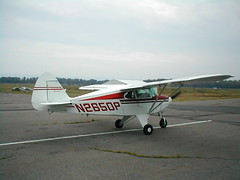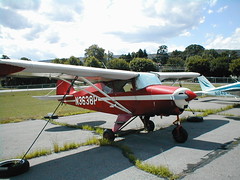OK, flash forward a year or so. I sold my farmhouse and apple orchard; which I was able to accomplish without a realtor, advertising and showing the house on my own. Another long story, there - but the short version is that I closed on the week before the 9-11 attack, and moved into my current small house in Scranton. That fall and winter I stayed very involved in Civil Air Patrol; it was a rough time for the aviation community anyway, and our squadron saw a big increase in volunteerism after the terrorist attacks. It was not until the following summer that I began shopping for planes again, as it seemed that private aviation would recover - but airplane prices were still quite low due to the uncertainty of new, more restrictive Federal regulations.
I started again with the Trade-A-Plane magazines, and browsing the bulletin boards at the local airports. But this time, it was a little red-and-white plane that caught my eye as I was driving by the Wyoming Valley airport - a Piper Tri-Pacer. I knew a little about these planes; the AOPA had restored one a few years earlier for their sweepstakes airplane, and I remembered being intrigued by the details. A four-seat plane, the most popular model made between 1951 and 1961, over nine thousand were built and nearly three thousand are still flying. Made of steel tubing and covered with fabric, it belonged to the generation before the riveted-aluminum Cessnas I was familiar with. But it was powered by the same reliable Lycoming engine, and offered similar performance, with a somewhat cramped cabin.
I contacted the seller, and arranged to go for a flight in the plane. He showed me around the Tri-Pacer and pointed out some of the quirks - the overhead crank for the trim, and the hand-operated brakes - and spoke with pride of the plane's performance. We taxied out and took off, and as soon as I took the controls, I was smiling. The little Piper leaped off the grass runway, and responded instantly to the controls. After hundreds of hours flying the stable, predictable Cessnas, I was taken by the way that this stubby plane handled in the air - like getting into a sportscar after driving a truck. And the performance was just as the seller described, matching the Cessna for cruise speed but able to take off and land in far less space.
That first flight had definitely set the hook, and sent me off to look for other Tri-Pacers. There are still quite a few on the market at any given time, and I wasn't convinced of the mechanical condition of the one I had flown (it had been parked outdoors for many years.) There was actually another one for sale at the same airport, a later model with some different options, including an auxilary fuel tank. But when I contacted this seller, it turned out that neither he nor the plane had flown in nine months - and he asked me if I wanted to go for a flight! NO, thank you; not until the pilot gets current, and the plane is thoroughly checked over by a mechanic! (You can get nightmares, imagining what can go wrong with a plane that sits idle for that long.)
I decided to cast my net wider, and spent some time looking at Tri-Pacers at greater distances. And I started reading the newsletter of the "Short-Wing Piper Club", the type club for these airplanes. The old fabric-covered Piper airplanes can be divided into two major families - the "Long-Wings" being the famous Cub and its derivatives, and the "Short-Wing" models, of which the Tri-Pacer was the last. Old Bill Piper was a clever manufacturer: each successive model of his airplanes (all built in Lock Haven, Pennsylvania) used as much as possible of the one before. So when an increase in engine power made it desirable to have a smaller wing, for higher cruise speed - rather than design a whole new wing, he just chopped six feet off of the classic Cub wing, and shortened the plane lengthwise as well. The final touch was the addition of a tall, sturdy tricycle landing gear - the first to be offered on any light plane - and the Tri-Pacer was born.
I watched the trade ads and the internet for the next few months, in no particular hurry, waiting for the right plane to catch my eye. And finally, one did; an eye-catching blue and yellow "Tripe" listed on Aircraft Shopper Online (a great site to window-shop, by the way!). I looked over the details, and the few small photos. It was a 1954 model, which meant a slightly less powerful engine, but the engine had been recently overhauled; the plane was recovered in modern fabrics and kept indoors; and the instrument panel was up-to-date with good modern gauges and radios. Importantly, the logbooks were complete back to 1954 and the title search was clean. The seller was very friendly and sent along more photos, copies of the logbook, and even some video clips of the plane in operation. Satisfied that I was close to a sale, I bought a one-way ticket to Nashville, leaving aside the problem of getting back if I DIDN'T buy the plane...
To be further continued...

